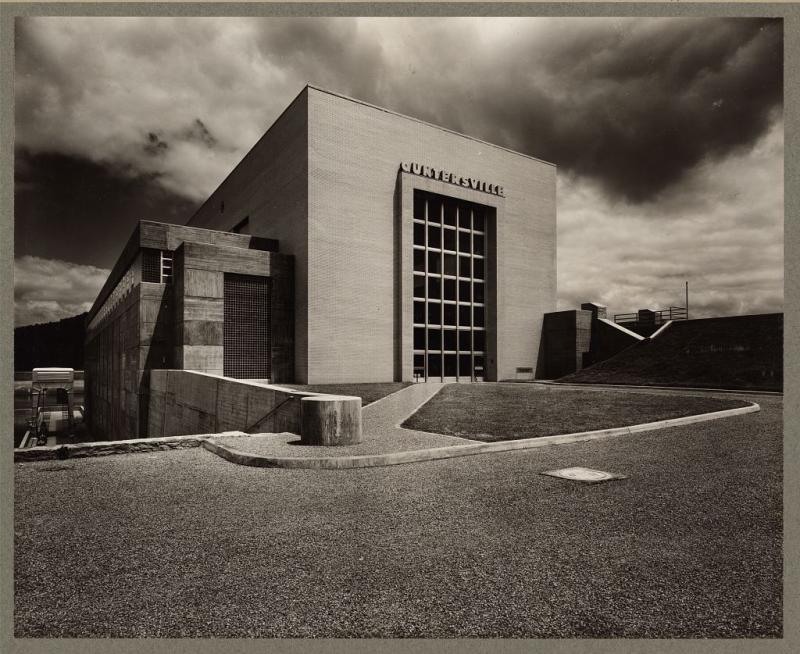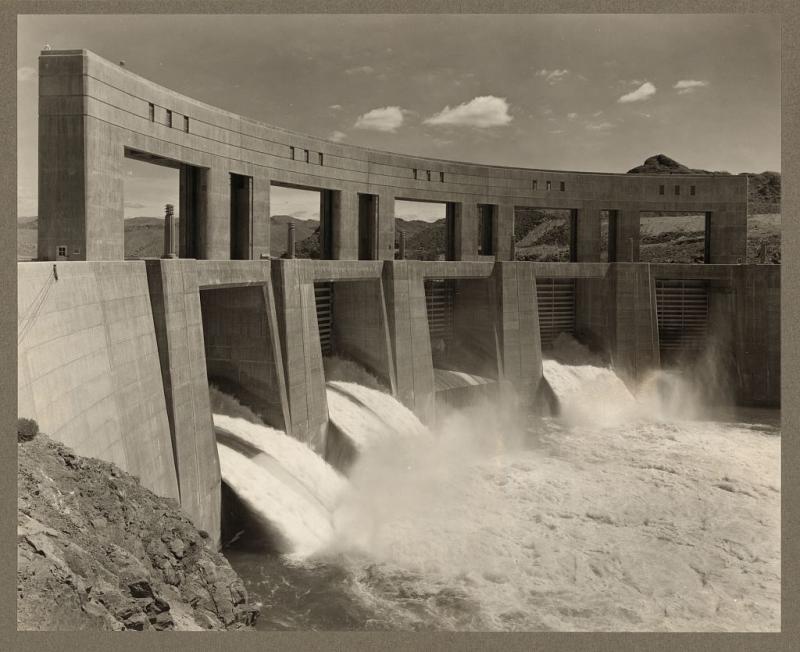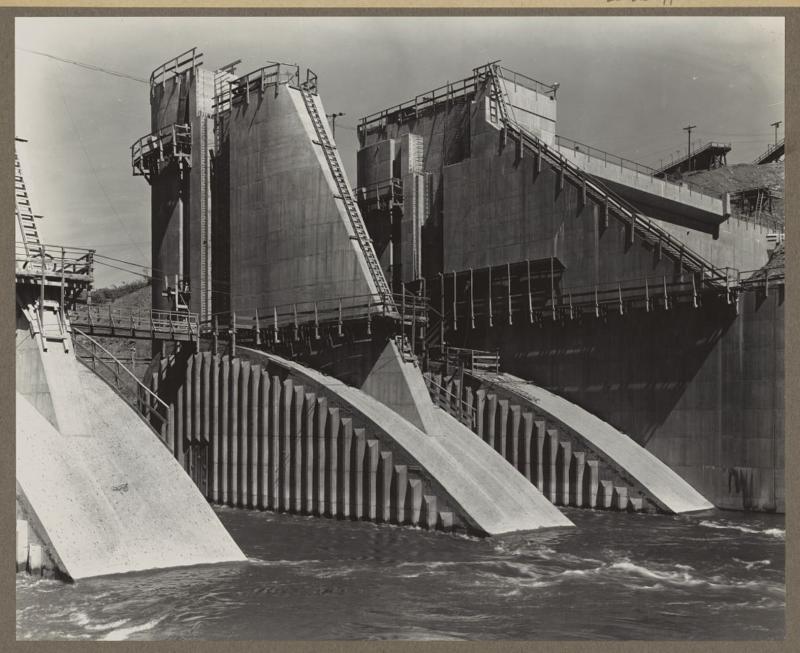The other day I posted a photo I found when looking for images about the many bombings that took place in the US in 1968.
The photo didn’t really have anything to do with bombings, per se, but it was an incredible photo (served up by Google because Grand Central Terminal was often considered a potential target by bombers and law enforcement) [stderr] I did a few reverse-image searches with tineye, and that led me to a mother-lode of great photography from the early 20th century.

Grand Central Terminal
John Collier was part of the Farm Administration/War Office effort to document American life – all of which is now available from the Library Of Congress. There’s Gordon Parks there, too; basically, a gigantic make-work program for arts and culture, which matched the equally giant technology and infrastructure make-work programs. Things were built, then, that simply never could be, today: dams, roads, national parks, bridges. When certain people talk about ‘tax and spend’ this is what they’re deriding: a massive movement of money from where it was piling up in capitalist and war profiteers’ bank accounts (let me use blunt language) and putting it to work to stimulate the civilian economy. Nowadays, when ultra-nationalists talk about “make america great again” they’re usually coupling that with a self-abnegating desire to break up unions, and cut taxes for the wealthy, and what they don’t realize is that those jobs they’re crying over are a knock-on effect of the massive civil engineering and militarization the US underwent after WWI and WWII.

Installing a generator at the Norris Dam, 1935
I don’t know what I like most: the number of jobs that installing the generator created, or the composition and lighting in the photo. I’m going to go with “both.” Where do giant generators come from, today? In 1935 they came from Pittsburgh, PA, and Rochester, NY, and Altoona, PA – the giant, smoking playgrounds of capitalists like Morgan, Carnegie, and Frick. Now they come from Sichuan in China [dongf] – it was more profitable for the capitalists to have them built there, and profits, not jobs, are what capitalists want.

Gunther Alamaba – TVA control house, 193?4
Steel and concrete, film and developer. Nowadays there are “fine art” photographers who try desperately to get tonal ranges and moods like that. This was just documenting the second American industrial age.

Pouring the spillways at the Grand Coulee Dam, 193?
Steel and concrete, earth-moving machines. The earth-moving machines became the technique for mountain-top strip-mining as it was practiced in Pennsylvania and Tennessee. The giant hydroelectric power plants produced the gigantic amounts of electricity needed for the Manahattan Project, Hanford, Oak Ridge. Oak Ridge,during its heyday created 75,000 jobs. That’s not a typo.

Parker Dam, 1941
Industrial-age art of industrial age art. Art and jobs. As a photographer, I am green with envy at the composition, use of lighting, and exposure. I think “sure, I’d have gone blacker on my blacks” but this was the photographic paper of the time. I’d guess this was probably shot on a 4×5 view camera – notice how the photographer made sure the verticals at each end of the dam’s top-structure are correct? It’s hard to do that with an SLR. And look at the little door on the left-hand side of the top-structure! Suddenly, you realize that those “vents” along the top of the curve are probably windows for viewing the spillway. Hubris!

Spillway of Keswick Dam, 1942

Friant Dam face, 1942
When people say “make america great again” they are probably remembering a grandparent who worked on something like this. My grandfather was a carpenter during WWII and assembled wooden aircraft hangars for the Air Force – he was proud until the day he died of how they could build an entire B-25 hangar in a day, and only had enough left over wood scraps for a small bonfire. When he spoke about the sense of unity and teamwork that his crew shared, his eyes would glow and he’d relax and start throwing back cup after cup of bitter black, boiling hot coffee.
The “make america great again” crowd are pursuing a real memory, but it’s not the memory they have been re-fed by the forces that control them. It’s the memory of the sense of purpose instilled in them by relentless wartime propaganda.
What made america great during that time was the totally militarized economy, resulting from three massive wars nearly back to back. One of the stories about WWII and the Manhattan Project that always struck me was how the CEO of Dupont told Leslie Groves, the general heading the Manhattan Project, “Dupont will provide you whatever assistance we can, gratis.” In other words, the capitalists helped boost the economy for the war effort by turning off the profit-valve for as long as it took. Teflon was invented for carrying uranium hexaflouride, which will apparently eat anything except Teflon; it worked out all right for Dupont.
You can tell that it was the wars, and not anything else, because between the wars there was economic collapse, and political uncertainty. What makes america great is when america saddles up and gets the steam up to go flatten and destroy someplace. That’s what gets america fired up.
But I don’t want to distract you from these beautiful photographs, which are part of american greatness. They’re all in the Library Of Congress – another great american institution – its gorgeous building was constructed in the early part of the great american industrialization, 1890, when Carnegie and Morgan and Mellon were transforming the country into monuments to their wealth. It is a great thing that america can afford to have such a collection of stuff. The Library of Congress has digitized these images and they’re all online.
Now let me tell you the mind-blowing part: those pictures above, I just grabbed them off a page at random. [here] Searching for “Farm Security” and “American Memory” gave back 280,000 such images. I pulled those masterpieces off the first page. It’s a huge collection and you can lose yourself searching around in it.
America isn’t building dams and power systems like that, anymore. Mostly, they’re trying to keep the old ones working, and to eke efficiency out of them where possible using advanced power-switching “smart grid” systems made in Germany and China. With, depending on who you believe, remote control by hackers in Russia. The big works, the dams, the steel mills – those have moved to where capitalists can take a bigger chunk of the action than they could in the US. And “foreigners stealing our jobs” will be the cry, but really the jobs were exported by the capitalists, because simply breaking the unions and dodging paying taxes wasn’t enough for them. Carnegie and Morgan and Frick got super-wealthy by gouging and abusing their workers – most of whom were immigrants who came, starving, to america to find food and work. They got work, all right, and their lives were shortened tremendously in the heat of 1200degree blast furnaces, no safety gear, and Pinkertons’ standing by to break their skulls if they complained and demanded a living wage. Now, the capitalists have moved the sweat-shops elsewhere; they’re making China “great”, now.

My friend Andrew Molitor writes a lot about images from the FSA [molitor] in his search for perfect negatives and images. If you’re interested in a sort of “theoretical mathematician’s take on composition” you might want to check out his writings.

Gawd, Marcus. When you nail a post, you really nail it!
Awesome and thought-provoking. Thank You.
I really don’t even know how to respond to “heartlanders” who burble about how Trump is a Biznessmuhn and he is making them proud. Because the same obedience? to propaganda and purpose has been given to a huckster, not a major war effort.
Well, it wasn’t just the wars. It was also the massive labour movement of the 1930s and 40s that organised after the Great Depression and held Roosevelt’s feet to the fire with threats of revolt and the overthrow of capitalism. Without a powerful united front of American Communists, Socialists and labour organisers to oppose them the capitalist class might have done after WWII what they did after WWI – resumed parasitism and economic instability with increased gusto. Instead the US got the New Deal.
It should also be noted that the reason the US could thrive after WWII was that every other economic rival it might have had was devastated by the war – particularly Germany, France and Japan. The UK suffered less (and we got a less drastic set of benefits out of the situation, like the NHS), but still had to relinquish claim to its last few Imperial possessions, leaving the international stage clear for one of the two countries that didn’t suffer any damage from the fighting to dominate (Canada didn’t seem to want to play the Imperialism game, even though it could have had a fair stab).
I would say that, in the latter half of the twentieth century, America’s chief source of greatness lay in our network of alliances around the world, and diplomacy or propaganda (take your pick) that made us admired and emulated even in countries we didn’t get along with.
The combination of isolationism, bullying, and cheap insults pursued by 45 seems almost calculated to destroy American greatness, not restore it. I often wonder if he really is a conscious Russian plant, instead of just an unwitting stooge.
What will *America* look like after all of this disintegrates?
https://en.wikipedia.org/wiki/Life_After_People
and about the top photo….
it’s the hats
everyone is wearing a hat
not a mesh-back baseball cap
but a proper hat
lady hats
gent hats
but they all wear hats
chigau, most wear hats, not all.
(… and when the elevator doors opened, a billow of smoke would come issue forth — often, not always;
… and cinemas had ashtrays on the seat armrests)
Well, there’s also the small matter of the 3.75 billion dollars worth of debt we owed to the US, which we only finished paying back in 2006…
Nope. The usual misconception is that it was a spin-off from the space programme, so well done for getting the historical period something like a bit closer, but no cigar. Teflon – polytetrafluoroethylene – was invented entirely by accident, by a dude called Plunkett who was trying to invent a better refrigerant gas, and the accident happened in 1938, a little before the Manhattan Project got off the ground.
sonofrojblake@#8:
Nope. The usual misconception is that it was a spin-off from the space programme, so well done for getting the historical period something like a bit closer, but no cigar.
Huh! I stand corrected.
I believe I got that tidbit from Leslie Groves’ Now it Can be Told – Groves was a military bureaucrat, not a materials scientist, so he could easily have gotten that wrong. I’m too lazy to go re-read that thing to verify, so flag me as “possibly wrong, too”
chigau@#5:
lady hats
gent hats
but they all wear hats
The US was pretty much under christian sharia law at the time.
Somehow, whenever a country is being made great, there is an increased demand for factory suicide nets. If human misery is the price for “making a country great”, I’d rather not have it. Same goes for war. Yes, being at war can scare people thus motivating them to work really hard, but there are some serious downsides.
Things were built, then, that simply never could be, today: dams, roads, national parks, bridges.
Sure, building a road or a bridge in China nowadays is easier (read: costs a lot cheaper) than in the developed world. Whenever lots of great things are being built somewhere, it usually indicates that there are lots of people whose only choices are either to work hard or to die from starvation. And in past (at least in Europe) people often didn’t even get a salary, they worked in exchange for food ration cards. Not to mention all the prisoners who were forced to “make their countries great”.
America isn’t building dams and power systems like that, anymore.
What a pity that wind and solar doesn’t look as impressive in photographs. Dams are bad for the environment by the way.
Lamenting the loss of steel mills is silly. If you want your country to get rich, you want to manufacture microchips and write software. Manufacturing steel or concrete or growing food crops is what poor countries are doing. Just take a look at how rich each country is and what they are exporting. There are some interesting correlations.
The idea of the good old days is false. The whole myth is the result of selective memory. Nostalgic people remember the good parts and forget/ignore the bad things.
Ieva Skrebele@#11:
What a pity that wind and solar doesn’t look as impressive in photographs.
Actually, they do. I can’t remember the photographers’ name but there were some wonderful stately images of giant wind farms shot in infrared against a deep black sky. I think that the reason there are so many photos of the public works projects is because part of the make-work was also hiring artists.
Ah, here it is:

Lamenting the loss of steel mills is silly.
Yes.
The idea of the good old days is false. The whole myth is the result of selective memory. Nostalgic people remember the good parts and forget/ignore the bad things.
A simpler theory: they’re being lied to.
OK, that is a cool photo.
A simpler theory: they’re being lied to.
Not necessarily. I suppose it depends on individual circumstances. Some people/families really had better living conditions a few decades ago. Therefore it is reasonable for them to remember that life was good for them and ignore the fact that it really sucked for the poor (and that’s selective memory). There are a bunch of nostalgic people even in countries without any politicians’ “Let’s Bring Back the Good Old Days” speeches. In Latvia most people believe that nowadays life is better than ever before. And I’d say that this is objectively true. But there are a few people nostalgic about USSR times. And all the nostalgic people share the fact that they had really good jobs back then, which meant above average living conditions.
“It is we who plowed the prairies; built the cities where they trade;
Dug the mines and built the workshops, endless miles of railroad laid;
Now we stand outcast and starving midst the wonders we have made;
But the union makes us strong.”- Solidarity Forever by Ralph Chaplin.
The tripartite balance of power that the Nordic countries and Germany have is actually pretty cool. Unions vs Capital seems not to work out so well in practice, but a well educated populace and a decent system of representative government does wonders to both improve the soft power of the unions so that hard power doesn’t have to be deployed.
@ 3 brucegee1962
I often wonder if he really is a conscious Russian plant, instead of just an unwitting stooge.
Vaguely possible but extremely doubtful, he is far too erratic for the FSB to want to try to recruit him. It would have been clear from initial vetting, heck from reading US newspapers that he was an unstable, narcissistic crook and not a good bet as an agent.
A money-launderer, well that could have been a different matter and might have been a prime candidate.
I do think that it is possible to make a good case for George W. Bush being an Al Qaeda agent.
The photo of Parker Dam is stunning. We don’t have any dams that big, but even so visiting the turbine hall of a hydroelectric power station in Scotland was awe inspiring, the whole thing is concealed inside a mountain so you’ve no idea of the size until you enter.